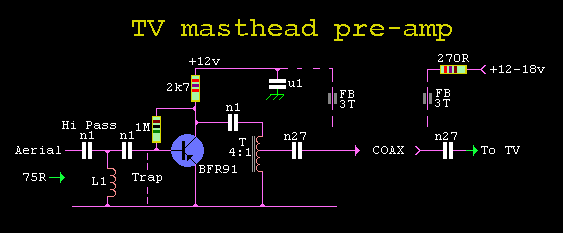By G8MNY (New Oct 07)
As a HAM I would not consider a broadband mixer @ the aerial a good idea!
Better 'gain' is to use low loss coax.
However it is possible to put low & high pass (UHF Band) filters into preamps, but most commercial ones are a poor attempts at this. Many makers insist on broadband amps that cover 40-900MHz so that can be used to amplify (& also MIX!) Band 1 TV, 6M, 4M, Band 2 Radio, 2M, Band 3 DAB Radio, 70cM Band 4-5 TV, & 900MHz cellphones etc.
Traps for specific ham bands are most effective if placed right on the 1st RF transistor's base, rather than in the feeding aerial lead.
(See my bul on VHF TVI filters for trap details.)
Basic circuit...

You can power this one from local 12V, the 2k7 & 1M are supposed to bias the transistor to 2.5mA for minimum noise maximum sensitivity. But higher gains & more linearity can be achieved if you change the bias as needed..
@ 2.5mA @ 12mA
Noise F 1dB 4dB
Gain 12dB 20dB
Bandwidth 300MHz-1GHz
So adjust the values to suit your needs.
The L is 2 turns 2mm diameter, the Transformer T is small ferrite bead with the 4 turns tapped at 2 turns, & presents a 300ê (4:1 Z) load to the transistor.
The input Cs I said use 2 x 100pF (n1) but 10pF may be better at removing VHF with not too much degradation @ 470MHz.
DC powering can be line fed, just put the 2k7 to the TV socket & decouple @ TV end to feed 12V in.
Tight UHF layout (next to no component leads!) is essential on a ground plane, so try an old tobacco tin (if U can find one!) & UGLY construction for best results. Etched PCB is so easy @ UHF with a sharp knife!
As there is no NFB in this design, the cross modulation is poor! Some commercial designs use 2 transistors with heavy NFB to throttle back the gain & attempt NFB @ UHF, Linearity may just be a few dBs better!
Poor linearity may affect the ability to Rx Digital TV, especially in the presence of strong analogue signals. Indeed I have seen a commercial UHF distribution amplifier fail on digital signals (made them worse), while the analogue was much improved & had NO evidence of any picture cross modulation!